Seasonic S12II: 330W to 500W of Silence
by Christoph Katzer on September 14, 2007 4:00 AM EST- Posted in
- Cases/Cooling/PSUs
Temperatures, Fan Speed and Acoustics
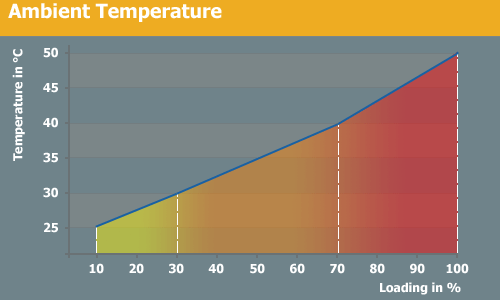
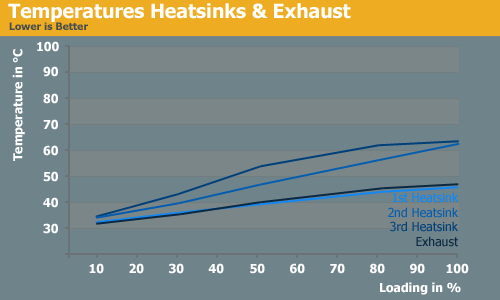
330W
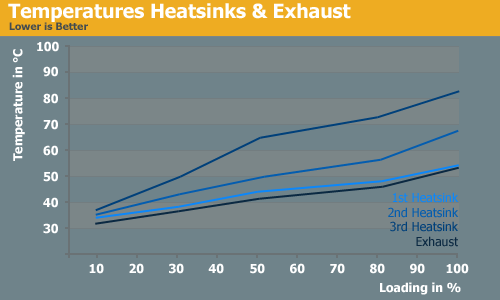
500W
Both temperature curves appear similar, and naturally the 500W version gets hotter. If you compare the two power supplies at similar loads in terms of Watts, the internal temperatures are almost the exact same in most cases. It's only once the 500W model exceeds 330W (66% load) that it clearly gets warmer. The third heatsink gets quite hot on the 500W unit, reaching 80°C at maximum load. This heatsink is located in the middle, which is something of a dead spot in terms of airflow and that probably accounts for the higher temperature. We have seen worse, but the still rising temperature suggests that the 500W power supply may not survive long in higher temperatures running at full load.
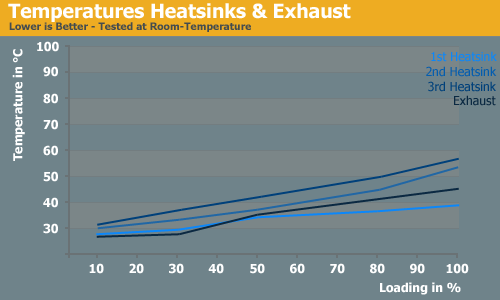
330W
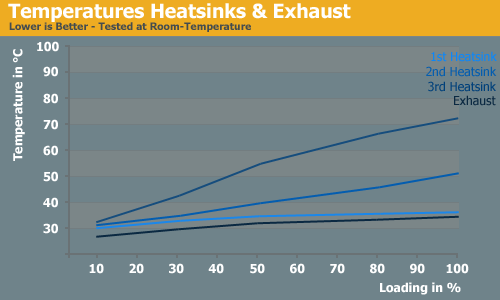
500W
In contrast, when testing at normal room temperatures the middle heatsink on the 500W version only reaches 72°C. The small 330W stays under 60°C and should not have any difficulties regardless of operating environment (within reason).
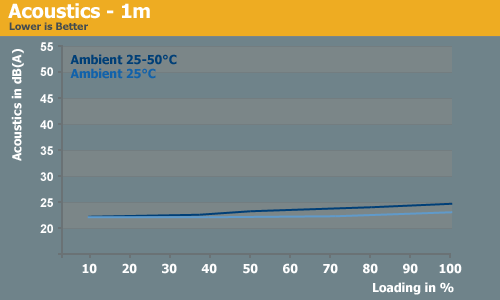
330W
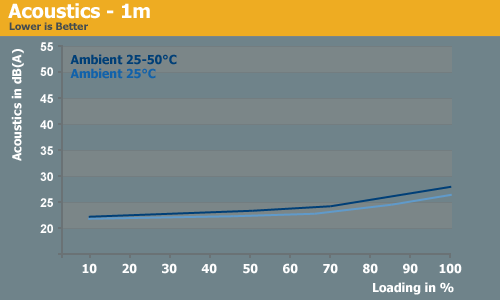
500W
If you're wondering what happened to the results, please direct your eyes towards the lower reaches of the charts. The 330W Seasonic reaches a maximum noise level of 25dB(A), while the 500W achieves an earsplitting 28dB(A). It's not easy to describe the noise of the fans since there simply isn't much to hear. The fans are whisper quiet and about the only thing you can hear is the sound of moving air if you hold your ear right next to the power supply. Quiet fans usually mean very little airflow, and without a proper design this could be problematic. However, as we have already seen in the temperature graphs there weren't any serious problems during stress tests lasting over six hours.
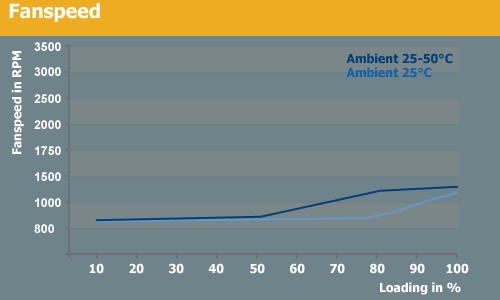
330W
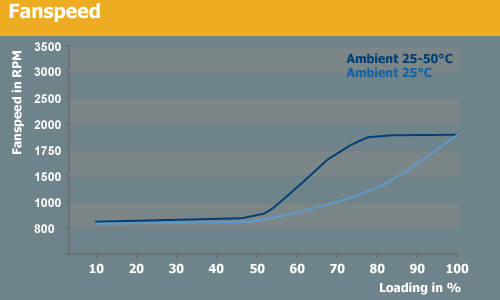
500W
The 330W S12II shows a very slow rotating fan that only reaches 1350 RPM, which helps to explain the low noise levels. The 500W model starts at around 850 RPM as well, but fan speed begins to increase passed the 50% load mark and reaches its maximum speed in stress testing at the 70% load mark. At normal room temperatures, the full speed is only reached at 100% load, so for the vast majority of users the fan will remain extremely quiet during use.


330W

500W
Both temperature curves appear similar, and naturally the 500W version gets hotter. If you compare the two power supplies at similar loads in terms of Watts, the internal temperatures are almost the exact same in most cases. It's only once the 500W model exceeds 330W (66% load) that it clearly gets warmer. The third heatsink gets quite hot on the 500W unit, reaching 80°C at maximum load. This heatsink is located in the middle, which is something of a dead spot in terms of airflow and that probably accounts for the higher temperature. We have seen worse, but the still rising temperature suggests that the 500W power supply may not survive long in higher temperatures running at full load.

330W

500W
In contrast, when testing at normal room temperatures the middle heatsink on the 500W version only reaches 72°C. The small 330W stays under 60°C and should not have any difficulties regardless of operating environment (within reason).

330W

500W
If you're wondering what happened to the results, please direct your eyes towards the lower reaches of the charts. The 330W Seasonic reaches a maximum noise level of 25dB(A), while the 500W achieves an earsplitting 28dB(A). It's not easy to describe the noise of the fans since there simply isn't much to hear. The fans are whisper quiet and about the only thing you can hear is the sound of moving air if you hold your ear right next to the power supply. Quiet fans usually mean very little airflow, and without a proper design this could be problematic. However, as we have already seen in the temperature graphs there weren't any serious problems during stress tests lasting over six hours.

330W

500W
The 330W S12II shows a very slow rotating fan that only reaches 1350 RPM, which helps to explain the low noise levels. The 500W model starts at around 850 RPM as well, but fan speed begins to increase passed the 50% load mark and reaches its maximum speed in stress testing at the 70% load mark. At normal room temperatures, the full speed is only reached at 100% load, so for the vast majority of users the fan will remain extremely quiet during use.










21 Comments
View All Comments
Zds - Wednesday, September 19, 2007 - link
Good review on a good product.What seemed a bit misleading, tho, was the statement about suitability of these models to dual-gpu machines. I know many marketing guys favor the "bigger is better", but it would not hurt to you, too, clearing out that the 330W model is powerful enough for practically any single-socket-single-GPU machine, and most of the dual-GPU ones, too and the 500W should be enough for almost any single-CPU-dual-GPU machine..
And as most of the modern machines (C2D/Athlon, not P4) spend most of their time at idle, and most of them idle at 60-100W, the 330W model saves not just your ears, but real money, as you can run the machine at the sweet spot almost all of the time.
gochichi - Sunday, September 16, 2007 - link
I have to say that Seasonic is not a flashy brand, like Antec or something. It's more of a truly better product, it doesn't rely on its name I don't think. Do a lot of people really know this name?From my experience, Antec is just plain average quality with a lot of marketing dollars ... and while I would buy Antec again, I wouldn't choose it over most other brands. In fact, I'd generally avoid it, as 2 Antec PSs burned out on me and 0 of any other brand, even duck brand ones haven't failed on me.
My Seasonic 330W is going strong for 2 years now and my system isn't exactly barebones although this power supply kept me away from the vulgar video card options.
While I'm tempted by the performance features of 8800's and 2900s, it's the elegance of power efficiency and silence that does the trick for me. After going through the very beginning of 3D acceleration, with the original Voodoo, I can attest to the fact that power hungry cards are best regarded as beta versions, as prototypes, as overclocked. As research and development, and priced for zealots.
In any case, I understand going with more wattage on the powersupply, I would do so myself (mostly, b/c I like having different operating systems in different hard drives). But Seasonic is quiet, classy, quality stuff that deserves my recommendation.
I would go as far as to call it an underdog brand, it's not Corsair, it's little mentioned in recommendations... but it's really good stuff. Seasonic is like delicious wine, in a world dominated by beer.
wibeasley - Saturday, September 15, 2007 - link
The 330 version has been at newegg for at least a month. The "II" designation of the series isn't obvious from the title, but the box image shows it. The specifications show it as well, under the "Series" value.http://www.newegg.com/Product/Product.asp?item=N82...">http://www.newegg.com/Product/Product.asp?item=N82...
bryanW1995 - Friday, September 14, 2007 - link
I'll take the 620 hx that I just paid 127 AR at mwave instead of 115 for the 550vx.USAF1 - Friday, September 14, 2007 - link
I'm still waiting to see a review of a Seasonic S12 Energy+ PSU. Seasonic claims a peak efficiency of 88%.Christoph Katzer - Friday, September 14, 2007 - link
Between that one and now are still around 20 other PSUs which are laying around here and want to be reviewed...tynopik - Friday, September 14, 2007 - link
several of the charts such as efficiency, PFC and noise should be done on a watts scale instead of a % load scale. This will enable a direct comparison between alternatives.If i have a 250W load, how does the efficiency and noise compare among the 300, 400 and 550W power supplies? It's impossible to tell currently
Christoph Katzer - Friday, September 14, 2007 - link
For what are the tables of page 6 then?tynopik - Friday, September 14, 2007 - link
well yes i can figure out 50% load on a 500w PS is about 250wso yes it is 'possible' to compare numbers between different reviews, but certainly not easy
and why use % load any ways? how is it relevant?
convenience wise it sure would be handy to make, for instance, a single efficiency chart and a single noise chart with all power supplies that have been tested so far so you could see how they compare across the range of interest
Christoph Katzer - Friday, September 14, 2007 - link
Sounds good with the comparison, have thought about it already for an upcoming price guide.